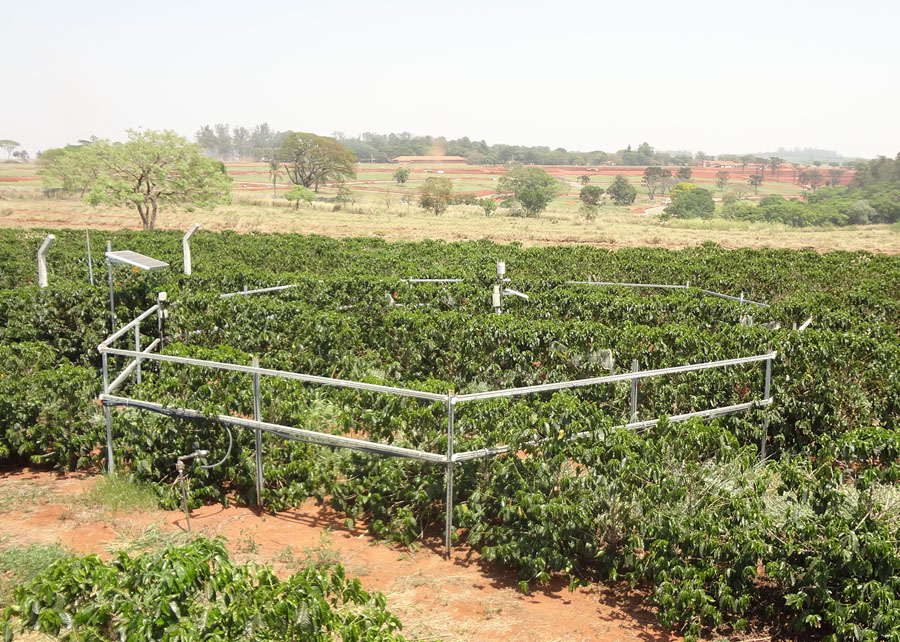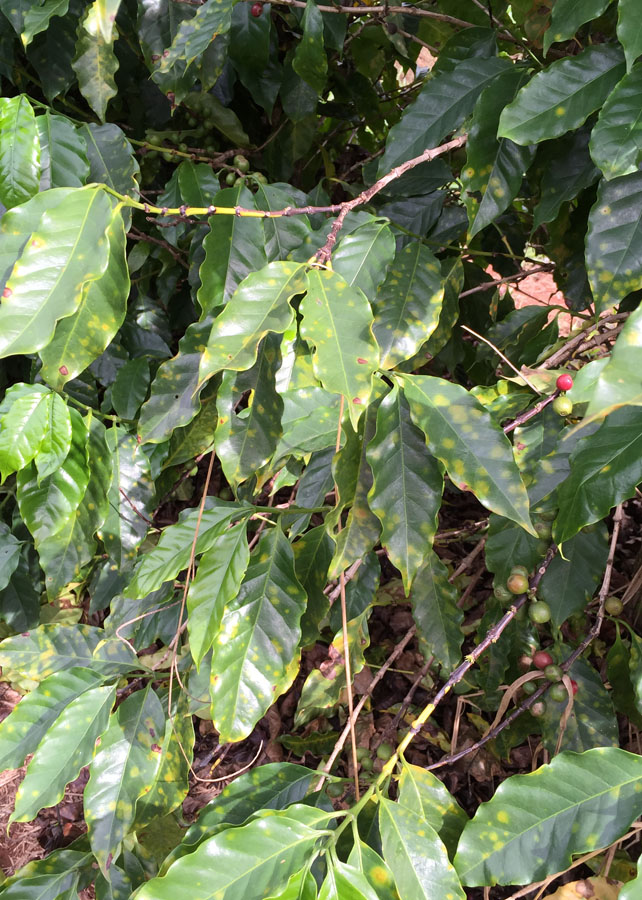Research shows that carbon dioxide can reduce the incidence of coffee leaf miner
Research shows that carbon dioxide can reduce the incidence of coffee leaf miner
Photo: Katia Nechet

Experimental parcels showing rings with the instrumentation for outdoor carbon dioxide injections and a weather station in the center of the parcel
|
A study developed by Embrapa Environment indicates that an increase in carbon dioxide (CO2) emissions reduces the incidence of coffee leaf miner, one of the worst coffee pests in Brazil, which can cause losses of up to 50% in the crop. The conclusion is the result of an experiment of the type entitled FACE - Free Air Carbon-dioxide Enrichment, which has been used by scientific research to obtain answers in intact natural agroecosystems. The work, which took place between 2011 and 2015, also showed positive impacts in plant heights, number of leaves and stem diameter, but no effect on the incidence of rust, another disease that is very harmful to the crop in the country.
FACE experiments allow open air carbon dioxide emissions to assess the effect of the gas in plants of agricultural interest. FACE Climapest, idealized by then Embrapa Environment researcher Raquel Ghini, was the first of its kind in Latin America and the only one in the world to study coffee cropping in such environment. Moreover, it was also a pioneer in prioritizing the study of plant health problems.
For the Embrapa Environment researcher Katia Nechet, climate change represents a threat to plants, but few studies consider its effect on plant pests and diseases, especially in tropical biomes with perennial crops. However, such information is crutial to point to future crop management strategies, especially regarding the climate, once cumulative carbon dioxide emissions to a large extent will determine global warming by the end of the 21st century, with a projected increase of around 1.5°C in global temperatures, according to the Intergovernmental Panel on Climate Change (IPCC).
“FACE Climapest allowed us to learn the effects of this increase in the coffee plants and their main pests and diseases, in studies performed outdoors, in more realistic conditions, to understand the effect of increased carbon dioxide in the incidence of pests and diseases. Experiments of the sort require studies that can take over three years for perennial plants like coffee”, explains Wagner Bettiol, another researcher at Embrapa Environment .
Brazil, the top largest coffee producer of the world, was responsible for 33.6% of the global production in the 2021/2022 crop year. Coffee rust and coffee leaf miner can lead to losses that vary from 30% to 50% and 30% to 70%, respectively. The study of relationship between climate variables and agricultural production is essential not only to identify the vulnerability of production systems, but also to propose adaptation strategies, aiming at ensuring food supply in the most diverse environmental conditions.
 Plant growth
Plant growth
Throughout the three years of assessment, the diameter of the coffee plants cultivated with high carbon dioxide concentration was between 3% and 12% larger than those subject to ambient CO2 concentration in all the assessments. The total number of leaves per branch showed variation along the evaluated period, as it was influenced by external factors beyond carbon dioxide, such as manual harvesting and incidence of pests, for instance. “In spite of that, out of the 17 assessments performed, 10 showed a higher number of leaves”, explains Regiane Iost, who participated in the experiment during her Master's and PhD studies at the State University of São Paulo (Unesp).
The incidence of coffee leaf rust on plants cultivated in treatments with increased carbon dioxide was low and statistically similar, in the years 2014 and 2015, in light of climate conditions and the application of fungicides. On the other hand, the incidence of coffee leaf miner was lower in plants cultivated with increased carbon dioxide, which showed the same trend pointed by preliminary results in the FACE Climapest between 2011 and 2013.
“It is known that the length of coffee leaf miner's full cycle is stronly influenced by temperatures. In the experiment, the temperature was similar for the treatments with different carbon dioxide concentrations, which suggests that the increase may be responsible for the lower occurrence of the disease”, Nechet explains.
Cristina Tordin (MTb 28.499/SP)
Embrapa Environment
Press inquiries
meio-ambiente.imprensa@embrapa.br
Phone number: +55 19 3311-2608
Translation: Mariana Medeiros (13044/DF)
Superintendency of Communications
Further information on the topic
Citizen Attention Service (SAC)
www.embrapa.br/contact-us/sac/

